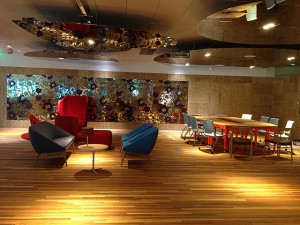Share This
Related Posts
Tags
LEED v4 Goes Live
By Yardi Blog Staff on Mar 4, 2014 in News
The U.S. Green Building Council (USGBC) officially launched LEED v4, the newest version of the LEED green building program, at the Greenbuild International Conference and Expo in Philadelphia.
Ever since the first LEED Pilot Project Program (also known as LEED Version 1.0) was introduced at the USG BC Membership Summit in August 1998, the LEED, or Leadership in Energy & Environmental Design program, has revolutionized the way buildings and communities are designed, constructed and operated.
BC Membership Summit in August 1998, the LEED, or Leadership in Energy & Environmental Design program, has revolutionized the way buildings and communities are designed, constructed and operated.
Whereas the first series of rating systems were developed to largely address the needs of owner-occupied new construction commercial buildings, the program has grown, evolved and expanded to encompass the different project development and delivery processes that exist in the U.S. building design and construction market, through rating systems for specific building typologies, sectors and project scopes: Core & Shell Development, New Construction and Major Renovations, Schools, Existing Buildings: Operations & Maintenance, Neighborhood Development, Retail, Healthcare, Homes, and Commercial Interiors. Moreover, LEED seeks to accelerate green building demand, delivery and accessibility and optimize the use of natural resources.
While still based on the essential principles advocated by its previous versions, LEED v4 brings a plus of coherence and efficiency to the whole process. “LEED v4 is a quantum leap for LEED,” said Rick Fedrizzi, president, CEO and founding chair, USGBC. “Over the past 15 years, LEED has fundamentally revolutionized how we design, construct, operate and maintain our buildings and communities. LEED has created a completely new industry of business enterprise committed to energy savings and efficiency. LEED v4 is as much a testament to the achievements of LEED project teams around the world as it is to the green building community’s ambition to create significant global and local change through resource-efficient, cost-effective green buildings.”
The program’s goal is to foster the creation of healthy communities, encourage sustainable development and prepare all LEED projects to achieve higher levels of building performance through the implementation of universally understood and accepted tools and performance criteria. USGBC says there are already 122 projects across the globe using the new LEED system.
Highlights of LEED v4 include:
- New market sectors: New market sector adaptations for LEED include data centers, warehouses and distribution centers, hospitality, existing schools, existing retail and mid-rise residential projects.
- Time saving support tools and resources: Simplified LEED credit submittal requirements, descriptive step-by-step reference guide materials with videos and tutorials, and a more intuitive technology platform.
- Building performance management: LEED v4 is focused on outcomes so that building owners have a better understanding of how to manage their buildings to meet full performance potential.
- New impact categories: Climate change, human health, water resources, biodiversity, green economy, community and natural resources. (USGBC)
“LEED v4, at its core, provides insight into the synergies within the building system, providing solutions for optimizing performance, and ultimately achieving better environmental, economic and social outcomes in our buildings,” explained Scot Horst, senior vice president of LEED, USGBC. “LEED v4 is the LEED of the future, where we challenge the marketplace to go further, to make the next great leap toward better, cleaner, healthier buildings where people live and work.”
Developers acknowledge the benefits of building green and choose to adhere to this innovative program that essentially promotes environmental stewardship, sustainable development, livability and social responsibility. USGBC estimates that more than 4.3 million people currently live and work in LEED-certified buildings, while more than 6.2 million people experience a LEED-certified project every day.
The Haworth Beijing Organic Showroom (pictured above) was recognized at the Greenbuild Expo as the first building to achieve LEED v4 Gold. Located in Parkview Green, a LEED v2009 Platinum building in the Chaoyang District of Beijing, China, this project certified its commercial interior space. The project is owned by Haworth, a world leader in office furniture, and the LEED process was administered by Bisagni Environmental Enterprise (BEE) Inc. Among several innovative features, and water and energy-efficiency solutions, Haworth brings forth the Club, a workspace concept where everything from partition walls, meeting rooms, and private focus areas can be rearranged to fit the day to day needs of its users. A low VOC environment promotes tenants’ comfort, well-being, and productivity by improving indoor air quality. Additionally, 90% of the appliances and equipment used in the showroom is Energy Star Rated; 60% of the interior features are reused elements, while 83% of waste was recycled rather than being taken to a landfill.
1800 K St. in Washington, D.C., was awarded LEED v4 Silver. The 224,000-square-foot office building is owned by Deutsche Asset & Wealth Management and managed by Transwestern. It obtained the premium certification under the Operations and Maintenance: Existing Building program.
“This is a tremendous achievement for Transwestern,” said Allan Skodowski, Transwestern’s managing senior vice president and director of LEED and sustainability services. “As the first in the industry to make sustainability the norm, it is truly an honor to be on the forefront of the next chapter in sustainability. The new LEED v4 rating system holds buildings to higher standards, and we are excited to see how much building sustainability improves with these new guidelines.”
Green improvements at the 1800 K St. property include a tenant engagement program; installation of MERV 13 filters at all outdoor air intake locations; upgrading all plumbing fixtures to meet WaterSense requirements; achieving an ENERGY STAR® rating of 81, offsetting 27 percent of electrical usage with sustainable power; recycling 61 percent of office waste; and implementing a sustainable purchasing program for all cleaning products and equipment.
Furthermore, three core and shell projects earned LEED precertification, as announced at the Expo: University Place in Philadelphia, 10 Emery St. in Bethlehem, Pa., and Capitol Tower Complex in Houston.
